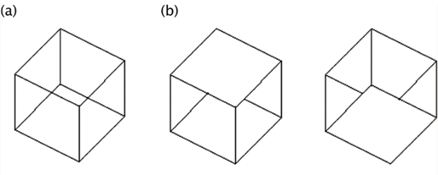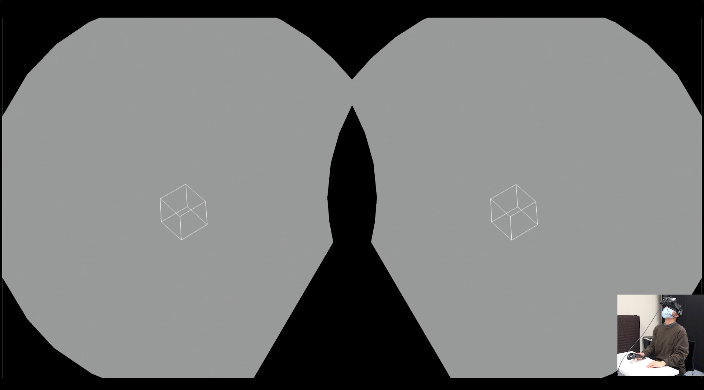
ここからコンテンツです。

Perception depends on whether you are looking up or down
Discovering that intensity of perceptual bias in specific views varies depending on posture Fumiaki Sato
A research team led by Fumiaki Sato, a doctoral student at the Department of Computer Science and Engineering, Toyohashi University of Technology with the support of the Japan Society for the Promotion of Science (JSPS) Research Fellowship for Young Scientists and professors Shigeki Nakauchi and Tetsuto Minami, discovered that the intensity of perceptual bias in specific views varies depending on the posture of the neck. This research investigated how changes in posture have a contextual effect on visual perception. Specifically, the experiment used the Necker cube as a visual stimulus that would potentially generate two different visual perceptions. In a virtual reality (VR) space, it placed the stimulus above and below each subject and asked them to report how it appeared in a posture that involved looking up at the stimulus and in another posture that involved looking down at it. The experiment revealed that the visual perception of the stimulus varied depending on the viewing posture.
The common belief is that whenever we see something, we perceive the image as cameras do. In fact, our visual perception is flexible, changing with circumstances and context. One well-known phenomenon is the color contrast effect, or the variation in how a specific color looks depending on the colors around it. The mechanism behind these shifts in perception is still largely unknown and investigating it is considered significant to understanding how our visual experience is constructed.

(a) used in the experiment potentially induces the view-from-above interpretation (left in (b)) and the view-from-below interpretation (right in (b)).
The human visual system processes a tremendous volume of information according to a method that is based on practical experience acquired through learning. This is called the heuristic method, and it has been made clear by a study on the interpretation of ambiguous figures. Take the Necker cube shown in the figure below for example. It is possible to perceive this cube in two different ways. Observers are more likely to recognize it as an image viewed from above than from below. This tendency in perception is called perceptual bias. It is understood that this bias arises from the fact that humans have more experience seeing a cube from above than from below in everyday life. It is known that the human visual system is thus susceptible to an experience-based context. However, it was unknown whether the experiential context is linked to physical posture.

(The Figure takes the form of a two-dimensional image that depicts a three-dimensional image. It may look partly distorted in this image.)
To resolve this point, the research team carried out an experiment using the Necker cube mentioned above to study changes in probability of perception. Participants were asked to how the Necker cube looked when it was placed at each of five different angles, specifically 60°, 30°, 0°, -30° and -60°, in a virtual space. The experiment was conducted not only under a vertical condition, defined as moving the neck vertically, but also under a horizontal condition, defined as moving the neck horizontally, which were provided as controlled conditions. It demonstrated that the probability of the view-from-above (VFA) interpretation is significantly higher in the state of looking vertically downwards than in the state of looking upwards. There was no significant difference observed under the horizontal condition.
Fumiaki Sato, the lead author of the research and a third-year student in the second half of the doctoral course, explains: "In daily life, there will almost certainly be differences in the frequency with which we view particular objects looking up at them or looking down at them. For example, we often see the sun, fluorescent lamps and other light sources when looking up. We rarely see them looking down. Our question was whether the difference in visual experience depending on posture leads to a difference in visual perception, and our experiment sought to answer this. This study employed a stimulus that would possibly induce two different visual interpretations despite constant input. This means that the information received on the retina is identical under any condition. However, the percentage of interpretations did vary depending on the posture. This suggests that the human visual system uses posture as a factor in determining the perception."
The research team has demonstrated that the human visual system flexibly modulates observers' perception according to their posture. This research is expected to help develop a model for the expression of human visual perception. The experiment measured the pupil diameter, believed to reflect the cognitive factor. Although details are not provided, the results suggest that the pupil size is closely related to the neck movement in the vertical direction. A future research objective will therefore be to explore the mechanism behind the links between the perception, the pupil diameter and the posture.
This research benefited from Grant-in-Aid for Scientific Research (B) for Changing the cognitive world using pupil diameter as an indicator (Grant Number 20H04273) and financial support for a joint research project on Interaction with virtual reality through pupillometry (Project Number 120219917) under the Bilateral Programs from the Ministry of Education, Culture, Sports, Science and Technology and the Japan Society for the Promotion of Science (JSPS). The lead author, Fumiaki Sato, also received a Grant-in-Aid for Scientific Research (Grant Number JP21J12947) from the JSPS.
Reference
Fumiaki Sato, Ryoya Shiomoto, Shigeki Nakauchi, Tetsuto Minami, Backward and forward neck tilt affects perceptual bias when interpreting ambiguous figures, Scientific reports, 12, 7276 (2022).
https://doi.org/10.1038/s41598-022-10985-4
見上げる、見下ろすことによって知覚する内容が変わる!
姿勢変化によって特定の見えにおける知覚バイアスの強さが変化することを発見佐藤 文昭
豊橋技術科学大学 情報・知能工学専攻博士後期課程 佐藤文昭(日本学術振興会特別研究員)、中内茂樹教授、南哲人教授らの研究チームは、見上げる、見下ろすといった姿勢変化によって、特定の見えにおける知覚バイアスの強さが変化することを発見しました。本研究では、姿勢変化が文脈効果として視知覚に反映されるのかについて調査されました。具体的には、ネッカーキューブと呼ばれる2種類の見え方を知覚することが可能な視覚刺激が実験に用いられました。実験では、バーチャルリアリティ(VR)空間内で、実験参加者の上下に刺激を呈示し、見上げる、見下ろすといった姿勢で刺激の見え方を応答してもらいました。その結果、刺激の見え方が観察姿勢に応じて変化していることがわかりました。
私たちがものを見るとき、カメラのように映像を切り取っているように考えがちですが、その時の状況や前後の文脈に応じて、意識にのぼる見えを柔軟に変化させています。例えば、周囲の色によって対象の色の見え方が異なる「色の対比効果」はよく知られた現象です。このように知覚を柔軟に調整する方法については、未解明な点が多く、これを調査することは、私たちの視覚経験がどのように形成されるかを知るために重要であると考えられています。
私たちの視覚系は膨大な情報を処理するために、「ヒューリスティック」と呼ばれる学習を通じて得られるような経験則に従って処理されています。このことは、曖昧な図形を呈示したときにどのように解釈されるかについて調査した研究によって明らかになっています。例えば、下図に示すように2種類の見え方を知覚することが可能な立方体(ネッカーキューブ)がある場合、観察者は下からではなく上からの視点の見えが知覚しやすい傾向があります(この知覚の偏りを知覚バイアスといいます)。これは日常生活において、立方体を下から覗き込んで見るより、上から眺める経験の方が多いために生じる現象であると考えられています。このように私たちの視覚系は経験的文脈の影響を受けることが知られています。しかし、この経験的文脈が身体の姿勢変化と結びついているかについては不明でした。
この点を明らかにするために、研究チームは前述したネッカーキューブを使用し、知覚内容の確率変化を調査しました。バーチャルリアリティ空間に5つの角度(60度,30度,0度,-30度,-60度)のいずれかに配置されたネッカーキューブの見えについて実験参加者に尋ねました。実験条件は、垂直条件の他に、統制条件として水平条件でも実験は行われました。その結果、垂直に見下ろした条件のほうが、見上げている状態よりも上から見た外観に見える確率が有意に高いことがわかりました。その一方、水平条件では有意な差はみられませんでした。
「私たちの日常生活では上を向いて見える物体と下を向くときに見る物体の経験頻度は異なっているはずです。例えば上を向くと太陽や蛍光灯といった光源をよく目にしますが、下を向いたときにこのような光源を見る機会は稀だと思います。このような姿勢に応じた視覚経験の違いによって私たちの視覚体験は異なるのか、疑問に持ち、実験を行いました。本研究では、入力が一定であるにもかかわらず、2種類の知覚体験が可能な刺激を用いたので網膜上の情報はどの条件でも一定なはずです。にもかかわらず、知覚率が姿勢に応じて異なったということは、私たちの視覚系では、知覚内容を決定するための手がかりとして姿勢変化を用いていることを示唆しています。」と筆頭著者である博士後期課程3年の佐藤文昭は説明します。
研究チームは、私たちの視覚系は、観察者の姿勢に応じて知覚内容を柔軟に調整されていることを示しました。この研究は、私たちの視覚がどのように表現されているかをモデル化するために役立っていくことが期待されます。また、本実験では認知的要因を反映するとされる瞳孔径についても計測されました。詳細は割愛しますが、瞳孔径は首の垂直方向の動きと密接に関係していることが示唆されました。そのため、どのようなメカニズムで知覚・瞳孔径と姿勢が結びついているのか調査することが今後の研究課題と言えます。
Researcher Profile

| Name | Fumiaki Sato |
|---|---|
| Affiliation | Department of Computer Science and Engineering |
| Title | Doctor Course Student |
| Fields of Research | Subjective Perception |
| Graduated KOSEN | National Institute of Technology, Oshima College |
ここでコンテンツ終わりです。
